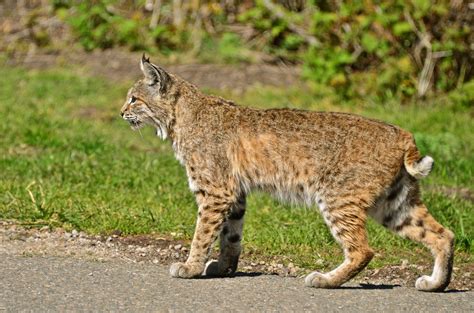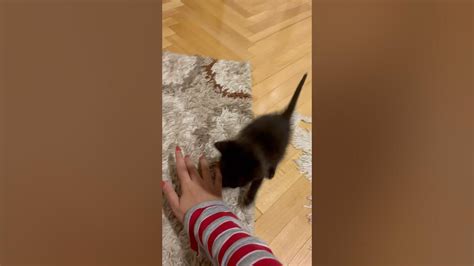
A Colorado family returned home to an unexpected houseguest: a bobcat that had made itself comfortable inside their residence, turning the home into its personal haven.
The incident, which occurred recently in Evergreen, Colorado, left homeowners stunned as they discovered the wild feline casually lounging in their home. According to officials, the bobcat entered through an open door, highlighting an unusual encounter between wildlife and domestic life. The Colorado Parks and Wildlife (CPW) officials were promptly notified and responded to the scene to handle the situation.
“We got a call about a bobcat inside a house in Evergreen,” said a CPW spokesperson. “It’s not every day you get that call.”
Upon arrival, CPW officers found the bobcat remarkably calm and unbothered by its new surroundings. The animal had explored multiple rooms, including bedrooms and living areas, leaving behind a trail of curiosity and bewilderment for the homeowners.
“The bobcat seemed quite relaxed, which is not always the case with wild animals in confined spaces,” the CPW officer noted. “It had clearly been enjoying its time indoors.”
Authorities believe the bobcat was likely seeking shelter or food, as the region has experienced fluctuations in weather patterns and the local wildlife habitat. The incident serves as a reminder of the increasing interactions between humans and wildlife as residential areas expand into natural habitats.
CPW officers successfully removed the bobcat from the home without incident. The animal was carefully tranquilized and transported to a nearby wilderness area, where it was released back into its natural environment.
“Our priority was to ensure the safety of both the homeowners and the bobcat,” the CPW spokesperson stated. “We were able to relocate the animal without any harm to anyone involved.”
The incident underscores the importance of securing homes and being mindful of local wildlife. Residents are advised to keep doors and windows closed, especially during dawn and dusk when wildlife is most active.
Bobcat’s Colorado Home Invasion: A Detailed Account
The seemingly tranquil town of Evergreen, Colorado, became the stage for an unusual wildlife encounter when a bobcat decided to take up temporary residence in a local home. The incident, which unfolded recently, has left homeowners reflecting on the increasing intersections between human habitats and the natural world.
The story began when a family returned to their Evergreen home, only to find an unexpected occupant casually exploring their living space. It wasn’t a stray cat or a lost dog, but a bobcat, a wild feline native to Colorado’s landscapes.
“It was quite a shock,” said one of the homeowners, who preferred to remain anonymous. “We opened the door, and there it was, just sitting there like it owned the place.”
The bobcat had apparently entered the home through an open or unsecured door. According to Colorado Parks and Wildlife (CPW) officials, the animal appeared to be seeking shelter or perhaps drawn by the scent of food.
“Bobcats are opportunistic animals,” explained a CPW officer. “They will explore any potential source of food or shelter, especially if they are young or inexperienced.”
Upon discovering the bobcat, the homeowners wisely contacted CPW, who dispatched officers to the scene. The officers arrived to find the bobcat exhibiting a surprisingly relaxed demeanor, despite being in an unfamiliar environment.
“What struck us was how calm it was,” said a CPW spokesperson. “Usually, a wild animal in a house is stressed and agitated. This one seemed almost…curious.”
The bobcat had apparently spent some time exploring the various rooms of the house, leaving a trail of bewildered amusement in its wake. It had wandered through bedrooms, investigated the living room, and even seemed interested in the kitchen.
“We found it in the living room, perched on the sofa,” the homeowner recounted. “It looked like it was watching TV.”
Given the potential risks associated with handling a wild animal, CPW officers decided to tranquilize the bobcat. This allowed them to safely capture and remove it from the home without causing harm to the animal or the homeowners.
“Our priority is always the safety of both the public and the animal,” the CPW officer emphasized. “Tranquilizing the bobcat was the safest option in this case.”
Once tranquilized, the bobcat was carefully transported to a nearby wilderness area, where it was released back into its natural habitat. The CPW officers ensured that the animal was far from residential areas, reducing the likelihood of future encounters.
“We released it in a remote area with plenty of prey and suitable habitat,” the CPW spokesperson confirmed. “It should be able to thrive there.”
The incident in Evergreen serves as a reminder of the growing interactions between humans and wildlife, particularly in areas where residential development encroaches on natural habitats. As human populations expand, wild animals are increasingly forced to navigate human-dominated landscapes, leading to potential conflicts.
“We are seeing more and more of these types of incidents,” said a wildlife biologist. “As we build further into wildlife habitats, animals are going to come into contact with humans more often.”
The CPW advises homeowners to take precautions to prevent wildlife from entering their homes. This includes keeping doors and windows closed, securing pet food and garbage, and trimming vegetation around the house.
“Simple steps can make a big difference,” the CPW officer explained. “By taking these precautions, you can reduce the chances of attracting wildlife to your property.”
Understanding Bobcat Behavior
Bobcats ( Lynx rufus ) are medium-sized wild cats that are native to North America. They are found in a variety of habitats, including forests, deserts, and mountains. Bobcats are adaptable animals that can survive in close proximity to humans, but they typically prefer to avoid human contact.
Bobcats are primarily nocturnal animals, meaning they are most active at night. They are skilled hunters, preying on a variety of small animals, including rabbits, rodents, birds, and reptiles. Bobcats are also known to occasionally hunt larger animals, such as deer.
“Bobcats are opportunistic hunters,” said a wildlife expert. “They will take advantage of any available food source.”
Bobcats are generally solitary animals, except during mating season. They typically have a home range of several square miles, which they mark with urine and scat. Bobcats are territorial animals and will defend their home range from other bobcats.
“Bobcats are very territorial,” the wildlife expert explained. “They will fiercely defend their territory from intruders.”
Bobcats are not typically aggressive towards humans, but they can become dangerous if they feel threatened or cornered. It is important to give bobcats plenty of space and avoid approaching them.
“If you encounter a bobcat, the best thing to do is to back away slowly and give it room to escape,” the CPW officer advised. “Do not try to approach or feed the animal.”
Preventing Wildlife Encounters
The incident in Evergreen highlights the importance of preventing wildlife encounters. As human populations continue to grow and expand into natural habitats, it is crucial to take steps to minimize conflicts between humans and wildlife.
Here are some tips for preventing wildlife encounters:
- Secure your home: Keep doors and windows closed, especially during dawn and dusk when wildlife is most active. Repair any holes or gaps in your home’s exterior.
- Store food properly: Store pet food and garbage in secure containers. Clean up any spilled food or crumbs.
- Trim vegetation: Trim vegetation around your home to reduce hiding places for wildlife. Remove any brush piles or woodpiles.
- Install fencing: Install fencing around your property to deter wildlife from entering.
- Avoid feeding wildlife: Do not feed wildlife, as this can attract them to your property and make them dependent on humans.
- Be aware of your surroundings: Be aware of your surroundings when you are outdoors. Keep an eye out for wildlife and avoid approaching them.
- Educate yourself: Learn about the wildlife in your area and how to avoid encounters.
By taking these precautions, you can help prevent wildlife encounters and protect both yourself and the animals.
The Broader Context: Human Encroachment and Wildlife Displacement
The Evergreen bobcat incident is not an isolated event. It reflects a broader trend of increasing human-wildlife interactions driven by human encroachment on natural habitats. As urban and suburban development expands, wildlife is forced to adapt to living in closer proximity to humans, often leading to conflicts.
“Wildlife is losing its habitat,” stated a conservationist. “As we build more homes and roads, we are fragmenting their habitat and forcing them to live closer to us.”
This habitat loss can have a significant impact on wildlife populations. Animals may struggle to find food, water, and shelter, and they may be more vulnerable to predators and diseases. In addition, habitat loss can disrupt animal migration patterns and lead to genetic isolation.
“Habitat loss is one of the biggest threats to wildlife,” the conservationist emphasized. “We need to do more to protect and restore wildlife habitats.”
In addition to habitat loss, human activities can also directly impact wildlife populations. Hunting, fishing, and trapping can reduce the number of animals in an area, and pollution can contaminate their food and water. Climate change is also having a growing impact on wildlife, altering their habitats and disrupting their life cycles.
“Climate change is exacerbating the problem,” said a climate scientist. “As the climate changes, wildlife is struggling to adapt.”
Addressing the issue of human-wildlife conflict requires a multi-faceted approach. This includes protecting and restoring wildlife habitats, reducing human encroachment, regulating hunting and fishing, and addressing climate change. It also requires educating the public about wildlife and promoting responsible behavior.
“We all have a role to play in protecting wildlife,” the conservationist concluded. “By working together, we can create a future where humans and wildlife can coexist.”
Colorado Parks and Wildlife’s Role in Mitigation
Colorado Parks and Wildlife (CPW) plays a crucial role in managing and conserving the state’s wildlife resources. The agency is responsible for protecting wildlife habitats, regulating hunting and fishing, and educating the public about wildlife. CPW also responds to wildlife conflicts, such as the bobcat incident in Evergreen.
“Our mission is to protect, preserve, enhance, and manage Colorado’s wildlife resources for the use, benefit, and enjoyment of the people of this state and its visitors,” the CPW website states.
CPW officers are trained to handle a variety of wildlife situations, from rescuing injured animals to resolving conflicts between humans and wildlife. They work closely with local communities to educate residents about wildlife and promote responsible behavior.
“We are committed to working with the public to ensure the safety of both humans and wildlife,” the CPW spokesperson said.
In the case of the Evergreen bobcat incident, CPW officers responded quickly and efficiently to remove the animal from the home without causing harm. They also provided the homeowners with information about how to prevent future wildlife encounters.
“We are always available to assist residents with wildlife issues,” the CPW officer said. “We encourage people to contact us if they have any concerns.”
CPW also conducts research to monitor wildlife populations and assess the impact of human activities on wildlife. This research helps the agency to make informed decisions about wildlife management.
“We rely on science to guide our management decisions,” the CPW wildlife biologist explained. “We are constantly learning about wildlife and how to best protect it.”
The Future of Human-Wildlife Interactions
The future of human-wildlife interactions is uncertain. As human populations continue to grow and expand, wildlife will increasingly be forced to adapt to living in close proximity to humans. This will likely lead to more conflicts between humans and wildlife.
“The trend is clear,” said a sociologist. “We are going to see more and more of these types of incidents in the future.”
However, there are steps that can be taken to mitigate the impact of human activities on wildlife. By protecting and restoring wildlife habitats, reducing human encroachment, regulating hunting and fishing, and addressing climate change, we can create a future where humans and wildlife can coexist.
“It’s not too late to make a difference,” the conservationist said. “But we need to act now.”
Education is also key to promoting responsible behavior and reducing conflicts between humans and wildlife. By educating the public about wildlife and how to avoid encounters, we can help to protect both humans and animals.
“Education is essential,” the CPW spokesperson emphasized. “The more people know about wildlife, the better they will be able to coexist with it.”
Ultimately, the future of human-wildlife interactions will depend on our ability to balance the needs of humans and wildlife. By working together, we can create a sustainable future where both humans and animals can thrive.
FAQ: Bobcat in Evergreen Home
1. How did the bobcat get into the house?
Authorities believe the bobcat likely entered through an open or unsecured door, possibly seeking shelter or food. The exact point of entry remains unconfirmed.
2. Was anyone injured during the incident?
No injuries were reported to either the homeowners or the CPW officers involved in the removal of the bobcat.
3. What did Colorado Parks and Wildlife (CPW) do with the bobcat?
CPW officers tranquilized the bobcat and safely removed it from the home. The animal was then transported to a nearby wilderness area and released back into its natural habitat.
4. What should I do if I find a bobcat in or near my home?
If you encounter a bobcat, remain calm and do not approach the animal. Keep a safe distance and contact your local Colorado Parks and Wildlife office for assistance. Do not attempt to handle or capture the animal yourself.
5. How can I prevent wildlife from entering my home?
To prevent wildlife from entering your home, keep doors and windows closed, especially during dawn and dusk. Secure pet food and garbage in tightly sealed containers. Trim vegetation around your home to reduce hiding places for animals. Consider installing fencing to deter wildlife from entering your property.









